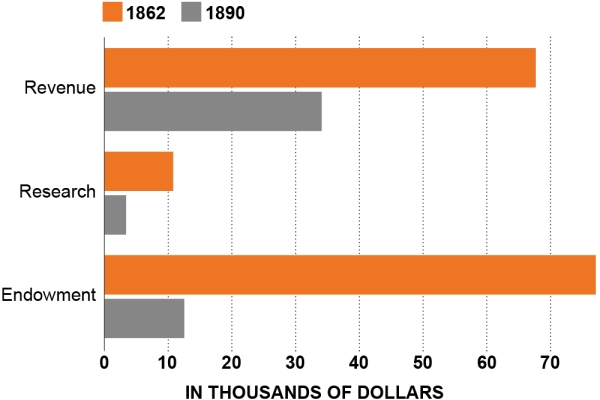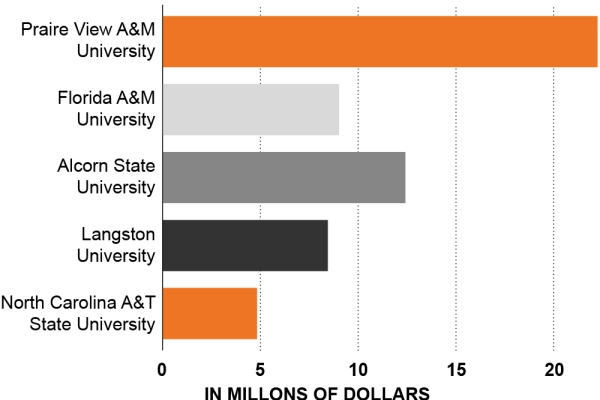[ad_1]
The nation’s 19 traditionally Black land-grant universities see the upcoming replace to the farm invoice as a chance to make up for historic underfunding and spend money on transferring these establishments ahead, advocates, directors and consultants say.
The farm invoice, final up to date in 2018, is a wide-ranging bundle of laws that authorizes applications and spending associated to agriculture and diet, together with tens of millions for agriculture analysis and extension companies for land-grant universities. The 2018 invoice included quite a few wins for the Black land-grants reminiscent of creating six new facilities of excellence and $80 million in scholarship funds for HBCU college students. Advocates are hoping to construct on these good points on this subsequent replace.
“Folks take a look at the farm invoice as simply one other piece of agriculture coverage, however actually, it is among the driving forces that gives key analysis, instructing and extension funding to the land-grant universities,” mentioned Denise Smith, a senior fellow at The Century Basis, a progressive suppose tank.
These steps have been modest, and never sufficient to make up for historic gaps, wrote Smith in a current report in regards to the underfunding of the Black land-grants, generally known as the 1890 universities due to the 12 months Congress established them, in comparison with predominantly white land-grant universities of their states.
Smith mentioned that “there is a huge distinction in wealth and entry between the establishment sorts” regardless of the very fact they have been based not that a few years aside. The historically white land-grants have been first established in 1862. There at the moment are 57 1862 universities and 36 tribal land-grant schools and universities. A current Heart for American Progress report additionally documented the disparities among the many three establishment sorts.
Evaluating Per-Pupil Income, Analysis and Endowment Assets


Century Basis, Inside Larger Ed evaluation
Smith advisable that Congress present $600 million in new obligatory funding over the subsequent 5 years to make up for a mixture of federal underfunding and the failure of states to supply matching funds that shortchanged the Black land-grant universities. She additionally needs Congress to make use of the farm invoice to higher help this group of establishments with new investments and coverage modifications.
“It is very important spend money on them, as a result of we’ve continued to have this narrative that these establishments do extra with much less, and it’s excessive time that they don’t do extra with much less,” she mentioned. “That is for the betterment of not solely simply the establishments, however for the nation.”
Republicans on the Home agriculture committee have mentioned they need to unveil a draft of the farm invoice subsequent month. Packages licensed within the invoice begin to expire on the finish of September. Congress may move an extension of the invoice by way of the top of the 12 months to provide lawmakers extra time to move an up to date invoice. Lawmakers have mentioned they don’t anticipate to have new cash for the farm invoice reauthorization, given Congress’s fiscal constraints.
Mortimer Neufville, president of the 1890 Universities Basis, a nonprofit centered on supporting its namesake establishments, mentioned the farm invoice is vital to the HBCUs as a result of they’re serving underserved populations.
“We’re caught within the crosshairs of doing extremely scientific work and doing utilized work to satisfy the wants of the audiences that we’re making an attempt to serve—rural communities and underserved communities,” he mentioned.
He’d wish to see Congress increase the variety of facilities of excellence at HBCU land-grants. The facilities began sluggish as a result of they weren’t absolutely funded till 2021.
“We’re already seeing the influence of a few of the facilities when it comes to pupil success and workforce growth,” he mentioned. “We’re in a position to help [the U.S. Department of Agriculture] in addressing a few of the workforce wants. We’re diet and well being and the way a few of our susceptible populations are. We try to satisfy their wants. So we obtained a late begin, however they’re making a particular influence.”
The 1890 Basis and the Affiliation of Public and Land-grant Universities need Congress to supply funding to improve establishments’ analysis amenities. APLU has requested $5 billion in new cash over the subsequent 5 years. Public agriculture colleges and schools have outdated amenities and are going through $11.5 billion in deferred upkeep prices.
“Lots of our amenities, actually, are so previous, it must be new development, not simply renovation,” Neufville mentioned.
Heidi Anderson, president of the College of Maryland Jap Shore, mentioned that infrastructure cash is vital. Bettering or rebuilding the college’s analysis amenities would value at the least $100 million, Anderson mentioned. The present labs are outdated and don’t work for college students and school.
“It could permit us to construct some new issues and in addition usher in some extra state-of-the-art tools,” she mentioned of the brand new cash. “If you are going to train the scholars easy methods to go on the market and train the farmers easy methods to do higher precision agriculture to develop crops higher, they want the tools to do it.”
The farm invoice units a ceiling when it comes to what Congress can spend, after which lawmakers dole out the precise {dollars} in the course of the annual appropriations course of.
Technically, the 1890 group ought to obtain at the least 30 % of what the 1862 group receives for analysis and 20 % of the extension funding, however the report discovered that Congress didn’t all the time comply with that rule. In actual fact, solely in the newest federal finances did the funding ranges comply with the legislation, in accordance with the Century Basis report.
Black land-grant universities have been shorted $436 million over 15 years, the report mentioned.
“Whereas 1862 universities acquired substantial assets to develop their educational applications, spend money on spectacular analysis amenities, and prolong companies past their campus partitions to native communities, 1890 universities continued to face deep disparities in federal help,” Smith wrote.
Smith advised that Congress double the ratios. The APLU has advised elevating the analysis and extension benchmarks to 40 % and 30 %, respectively.
Even when the federal authorities provides Black land-grant universities cash for analysis and extension companies, states need to match that cash greenback for greenback, or the colleges may forfeit the cash.
Neufville mentioned that the required match has been the ceiling relatively than the ground for the 1890 establishments, whereas the 1862 group is funded at larger ratios.
“The USDA requires a 1:1 match as the ground at the least, however in lots of instances, we try to achieve that 1:1 match,” he mentioned.
Federal legislation permits states to choose out of the requirement for the 1890 group and solely kick in half in matching funds. That’s how this group misplaced out on $200 million in state funding from 2011 to 2022, in accordance with the Century Basis report. Universities additionally need to request a waiver from the federal authorities to keep away from dropping the analysis and extension {dollars} when the states fail to satisfy their obligation.
“For these establishments that don’t obtain their full state match, the results are vital when it comes to lack of wanted assets to spend money on analysis and extension companies that profit rural farmers and communities,” the report says.
State Matching Shortfalls at 1890 Universities from 2018–21


Maryland Jap Shore has missed out on $1.76 million in state matching funds from fiscal years 2018 to 2021, in accordance with the Century Basis report.
In 2021, Maryland agreed to a $577 million settlement in a federal lawsuit that accused the state of underfunding the entire state’s HBCUs and creating competing applications at predominantly white establishments.
Anderson mentioned her college was in a position to safe the 1:1 match this 12 months.
“We would like it to be everlasting going ahead, so we do not have to go and ask each single 12 months and that makes a distinction,” she mentioned.
Extra states have began to supply the total match for the Black land-grants in recent times, which Smith chalks as much as higher scrutiny of the difficulty, together with lawsuits. In fiscal 12 months 2021, the 1890 universities misplaced $22 million in state matching funds.
The report recommends phasing out the waiver fully by 2026.
“Through the years, states haven’t had an issue discovering the assets to completely fund the white land-grant establishments,” the report says. “It’s previous time to finish their discrimination in opposition to Black land-grant establishments.”
[ad_2]

